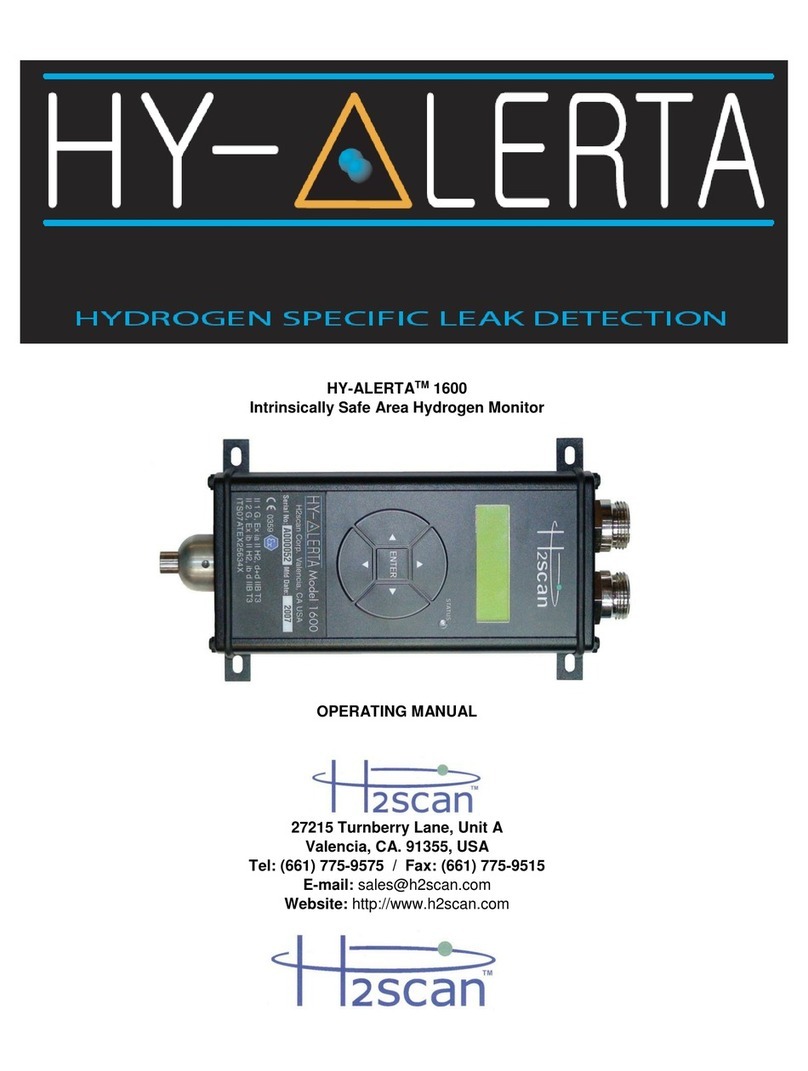
HY-ALERTATM 500 HANDHELD HYDROGEN LEAK
DETECTOR OPERATING MANUAL
90000002 R13 Page 4 of 14
IMPORTANT NOTICES
Read and understand this operating manual before installing or using the unit.
Only use cables, battery pack, battery charger, and AC/DC power supply from H2scan with this unit.
If this equipment is used in a manner not specified by H2scan, the protection provided by this equipment may be
impaired.
Hydrogen is flammable at 4% in air. Take indications seriously and be prepared to take action. In the event of
detection of 4% or higher of a hydrogen gas concentration there is a high probability of a hazard to safety. Inform
local emergency response personnel immediately.
Any exposure to condensation will damage the sensor. The sensor die is made of a Palladium Nickel film and is
sensitive to any form of condensation (organic and aqueous). Keep the sensor die dry.
Limitation of Liability: SELLER SHALL UNDER NO CIRCUMSTANCES BE LIABLE FOR ANY INCIDENTAL, CONSEQUENTIAL, SPECIAL,
PUNITIVE, OR OTHER DAMAGES, INCLUDING, BUT NOT LIMITED TO, LOSS OF BUSINESS OR PROFIT, PROMOTIONAL OR MANUFACTURING
EXPENSES, INJURY TO REPUTATION, OR LOSS OF CUSTOMER, BASED ON ANY ALLEGED NEGLIGENCE, BREACH OF WARRANTY, STRICT
LIABILITY, BREACH OF CONTRACT, OR ANY OTHER LEGAL THEORY ARISING OUT OF THE USE, MISUSE, PURCHASE, SALE OR
POSSESSION OF ITS GOODS OR ITS PERFORMANCE OF THIS CONTRACT TO THE EXTENT THAT SUCH LIABILITY EXTENDS SELLER’S
OBLIGATIONS BEYOND THE PRICE PAID BY BUYER TO SELLER FOR THE ITEM ON WHICH SUCH CLAIM IS BASED. SELLER ADVISES BUYER
TO PERFORM ACCEPTABLE TESTS ON ALL HARDWARE PRIOR TO DEPLOYMENT AND TO PERFORM MAINTENANCE AS DESCRIBED IN THE
SELLER’S INSTRUCTION GUIDE. UNDER NO CIRCUMSTANCES SHALL THE EQUIPMENT PROVIDED HEREUNDER BE USED IN A MANNER
WHERE IT IS THE SOLE PROTECTIVE SYSTEM FOR FACILITIES, EQUIPMENT AND PERSONNEL SAFETY; THE EQUIPMENT IS INTENDED
FOR USE IN CONUNCTION WITH OTHER APPROPRIATE PROTECTIVE SYSTEMS.
LIMITED WARRANTY
H2scan Limited Warranty: Each hydrogen instrument (“Product”) will conform, as to all substantial operational features, to the Product
specifications set forth this Manual and will be free of defects which substantially affect such Product’s performance for twelve (12) months from
the ship date for such Product.
Must Provide Notice of Defect: If you believe a Product that you believe is defective, you must notify H2scan in writing, within ten (10) days of
receipt of such Product, of your claim regarding any such defect.
Return Product to H2scan for Repair, Replacement or Credit: If the Product is found defective by H2scan, H2scan’s sole obligation under this
warranty is to either (i) repair the Product, (ii) replace the Product, or (iii) issue a credit for the purchase price for such Product, the particular
remedy to be determined [by H2scan] on a case-by-case basis.
Voided Warranty: H2scan’s 12 Month Limited Warranty is void for any of the following:
The unit is opened and the manufacturing seal is broken
Unauthorized repair work performed at the customer’s location or carried out by anyone other than H2scan’s factory trained technicians
Equipment or parts that have been tampered with, misused, neglected, mishandled, improperly adjusted, or modified in any way without the
written consent of H2scan.
Equipment or parts that have been damaged due to shipping, misuse, accidents, mishandling, neglect, or problems with electrical power sources.
Repair work performed during the warranty period does not prolong the warranty period past the original period.
System operation in incorrect or inappropriate environments.
Usage that is not in accordance with system guidelines or an operator’s failure to follow manual instructions.
LIMITATION OF WARRANTY: THE ABOVE IS A LIMITED WARRANTY AS IT IS THE ONLY WARRANTY MADE
BY H2SCAN. H2SCAN MAKES NO OTHER WARRANTY EXPRESS OR IMPLIED AND EXPRESSLY EXCLUDES
ALL WARRANTIES OF MERCHANTABILITY AND FITNESS FOR A PARTICULAR PURPOSE. YOUR SOLE
REMEDY HEREUNDER IS REPAIR OR REPLACEMENT OF THE PRODUCT OR A CREDIT FOR THE
PURCHASE PRICE FOR SUCH PRODUCT, THE PARTICULAR REMEDY TO BE DETERMINED BY H2SCAN ON
A CASE-BY-CASE BASIS. H2SCAN SHALL HAVE NO LIABILITY WITH RESPECT TO ITS OBLIGATIONS UNDER
THIS AGREEMENT FOR CONSEQUENTIAL, EXEMPLARY, OR INCIDENTAL DAMAGES EVEN IF IT HAS BEEN
ADVISED OF THE POSSIBILITY OF SUCH DAMAGES. THE STATED EXPRESS WARRANTY IS IN LIEU OF ALL
LIABILITIES OR OBLIGATIONS OF H2SCAN FOR DAMAGES ARISING OUT OF OR IN CONNECTION WITH THE
DELIVERY, USE OR PERFORMANCE OF THE PRODUCTS.




























